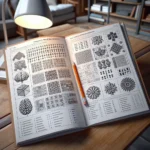The Comprehensive Test of Nonverbal Intelligence (CTONI) is a widely used psychological assessment tool designed to measure the intelligence and cognitive abilities of individuals from a nonverbal standpoint. The tool is particularly valuable for evaluating persons who may be disadvantaged by traditional tests that are language-heavy or biased toward individuals with strong linguistic skills. The CTONI is critical for psychologists, educators, and professionals involved in cognitive assessment and intelligence testing, providing insights into an individual’s nonverbal intelligence which can be essential for diagnosis, educational planning, and tailored interventions.
Developed by Dr. Donald D. Hammill, Dr. Nils A. Pearson, and Dr. J. Lee Wiederholt, the CTONI assesses intelligence free from the influence of language proficiency. This characteristic of the CTONI makes it especially advantageous for testing individuals with speech or hearing impairments, those with limited English proficiency, or anyone for whom verbal communication is a challenge. It is also suitable for a wide age range, typically from 6 years through to adulthood, making it a versatile tool applicable across different life stages.
The CTONI measures various aspects of nonverbal intelligence through six subtests that are divided into two scales: Pictorial and Geometric. The Pictorial scale includes the subtests of categories, sequences, and analogies, which use pictures of objects and themes familiar to most individuals, irrespective of their cultural or linguistic background. Meanwhile, the Geometric scale consists of the same three types of subtests but employs abstract shapes and designs instead of recognizable pictures.
Performance on these subtests is assessed based on the individual’s ability to form concepts, solve problems, and demonstrate reasoning skills without relying on language. During the test, participants are asked to identify relationships between figures, determine sequences, and select the item that best completes an analogy. It requires individuals to use critical thinking and problem-solving skills that are not dependent on verbal or language-based knowledge.
Test administration and scoring of the CTONI are straightforward. The assessor presents a series of visual tasks to the participant, who then selects or points to the appropriate answer from a set of options. The test is untimed, which allows individuals to work through the challenges at a pace that is comfortable for them, reducing any stress or anxiety associated with timed tests. Scoring involves assigning points for each correct answer and summing them to produce raw scores. These raw scores can then be converted to standard scores, percentile ranks, and age equivalents, providing a comprehensive understanding of the individual’s nonverbal intellectual abilities.
The CTONI provides several statistical benefits, including its strong psychometric properties. It possesses high reliability, meaning that its results are consistent and dependable over repeated administrations. It also shows a high validity, indicating that it accurately measures what it purports to measure – a person’s nonverbal cognitive abilities.
One of the key advantages of the CTONI is its fairness across diverse populations. Traditional intelligence tests have often been criticized for cultural and language biases that can disadvantage certain groups. Since the CTONI does not rely on language, it can be a fairer measure of cognitive ability for individuals from various linguistic and cultural backgrounds. This is incredibly important in a world that is increasingly diverse and where equitable assessment practices are sought after.
Professionals can use the CTONI in various settings, including educational environments, clinical practices, and research facilities. In the educational context, the tool helps identify strengths and challenges in a student’s cognitive profile. This can be particularly useful in determining eligibility for gifted programs or special education services where nonverbal intelligence plays a vital role. Clinicians may employ the CTONI as part of a battery of assessments to diagnose cognitive developmental disorders or to evaluate the impact of neurological events, such as stroke or traumatic brain injury, on cognitive functions. Researchers also utilize the CTONI in studies investigating cognitive processes, neurodevelopmental conditions, or the effectiveness of specific interventions.
When interpreting CTONI results, professionals must consider a range of factors, including the individual’s background, experiences, and any sensory or motor impairments that may impact their ability to engage with the test materials. It is also essential to integrate the findings from the CTONI with other sources of information, such as academic records, observations, and interviews, to build a comprehensive understanding of the individual’s nonverbal intelligence and overall cognitive functioning.
Moreover, the CTONI can play a role in intervention and support planning. For individuals who demonstrate particular cognitive strengths or weaknesses, tailored interventions can be designed to harness their potential or support areas of challenge. Educational strategies, accommodations, and support services are more effectively aligned with an individual’s needs when informed by a clear picture of their nonverbal cognitive abilities.
In conclusion, the Comprehensive Test of Nonverbal Intelligence (CTONI) is an indispensable assessment tool for measuring an individual’s nonverbal intelligence in ways that are unbiased by linguistic capabilities. It stands out for its versatility, reliability, fairness across diverse populations, and its practical applications in educational and clinical settings. Professionals who engage with the CTONI can glean valuable insights that contribute to informed decision-making regarding diagnoses, educational planning, and support strategies. As societies continue to recognize the importance of equitable and inclusive assessment practices, the CTONI will likely remain a gold standard in nonverbal intelligence testing for many years to come.

